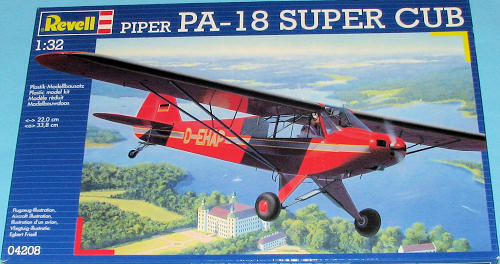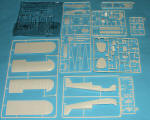
Revell 1/32 PA-18 Super Cub
| KIT: | Revell 1/32 PA-18 Super Cub |
| KIT #: | 04208 |
| PRICE: | $30.80 from GreatModels |
| DECALS: | Four options |
| REVIEWER: | Scott Van Aken |
| NOTES: | New mold kit: Full engine. |

| HISTORY |
Early in 1948, Piper assigned the model designation PA-18 to an improved version of the PA-17 Vagabond, which was to be introduced to the marketplace in 1949. A Continental C-90 powered prototype was built and tested, but Piper decided to cancel the program early in 1949.
At the same time the company was developing the PA-19, which was a version of the PA-11 cub Special for the U.S. Army. Only three were built and one of them, N5011H (Ser. No. 19-1), would serve as the certification test bed for the installation of the Continental (1-90-12F; Lycoming 0-235- C1 and O-290-D. The PA-11 airframe was unchanged, except for a revised center section and the use of the more rounded rudder that was first used on the J-4 Cub Coupe. The PA-11, which was an updated J-3, had retained the more angular Cub rudder. (An interesting side note: When Dick Wagner developed his Cuby, Wagabond and 2+2 kits, all were fitted with J-3 rudders. Reason: Dick had purchased all the J-3 inventory left at Piper's old Ponca City, OK plant, which included a barn full of J-3 elevators, stabilizers, gear legs and rudders. Golda and I were there in Lyons. WI to see them shoals after Dick returned home with the first semi load of goodies)
Military orders for the PA-19 that Piper Aircraft hoped for did not immediately materialize, so the company decided to ''civilianize'' the design and market it as the Super Cub. Rather than advancing to the next model designation, which would have been PA-20, Piper chose to go backward and assign the unused PA-18 designation to the Super Cub. Actually, by this time the PA-20 designation had already been assigned to the four-place Pacer, so the only other alternative would have been to jump ahead to PA-21! All this model designation confustion came about because these different airplanes were under development at the same time.
Finally, however, things were sorted out and the Super Cubs went into production - replacing the PA-11 on the production line in November of 1949. The very first Super Cub was N5410H, Ser. No. 18-1 . It is still on the FAA'S books today - registered to Eugene Frank of Caldwell, ID, who has been deceased for a number of years. There's a vintage treasure for someone to unearth and restore.
Super Cubs were certified and produced by Piper Aircraft with five different engines (plus several dash number variants of those engines).
Along the way a variety of sub models were produced, including PA-18s seaplanes and PA-18A ag planes. A total of 1,493 were built for the Air Force and Army as L-18s and L-21s, and many of those were sent to foreign countries under the Mutual Defense Aid Pact. The military models were ordered and built in blocks of serial numbered right along with the civilian production.
In total, Piper Aircraft built 10,326 Super Cubs between 1949 and 1994. Just 44 were built at Vero Beach - all the rest at Lock Haven. The biggest year for Super Cub production was 1953, when 1043 were built.
Like the J-3s and PA-11s before them, most Super Cubs were initially used as working airplanes. They served as trainers, dusters and sprayers, banner towers, pipeline and bowerlike patrollers, border patrollers, military liaison aircraft, bush planes and in any other way pilots could use and abuse them. Few aircraft have ever been subjected to more aftermarket modifications than the Super Cub - in fact in their efforts to squeeze out more performance, Alaskan bush pilots have sometimes rendered them virtually unidentifiable as PA-18s.
The Super Cub, however, did not die when Piper Aircraft ceased production in 1994. A host of small companies simply tooled up and began building their own versions of the airplane - in kit form to avoid the cost of certification. There are even turboprop versions flying today!
| THE KIT |
 This
latest one from Revell AG continues their work in the civil sector. If you
look at the Revell AG catalogue, you will see that they have been producing
a few of these types every year and have amassed quite a nice selection.
This one is everything we have come to expect from Revell AG. A well
engineered kit with a lot of detail and not asking the moon when it comes to
price. Were a certain Chinese company to produce this, not only would there
be errors in shape, but we'd be paying twice as much for it.
This
latest one from Revell AG continues their work in the civil sector. If you
look at the Revell AG catalogue, you will see that they have been producing
a few of these types every year and have amassed quite a nice selection.
This one is everything we have come to expect from Revell AG. A well
engineered kit with a lot of detail and not asking the moon when it comes to
price. Were a certain Chinese company to produce this, not only would there
be errors in shape, but we'd be paying twice as much for it.  very hefty wing spar. This is incorporated in the upper clear part and
should help to keep those wings on nice and tight.
very hefty wing spar. This is incorporated in the upper clear part and
should help to keep those wings on nice and tight. | CONCLUSIONS |
If you are like me, you have more kits than time and this one will be one more on an ever-growing 'must build' pile.
| REFERENCES |
http://supercubproject.sturmcity.net/
July 2008
You can find this kit and a ton of others at GreatModels
If you would like your product reviewed fairly and quickly, please contact me or see other details in the Note to Contributors.